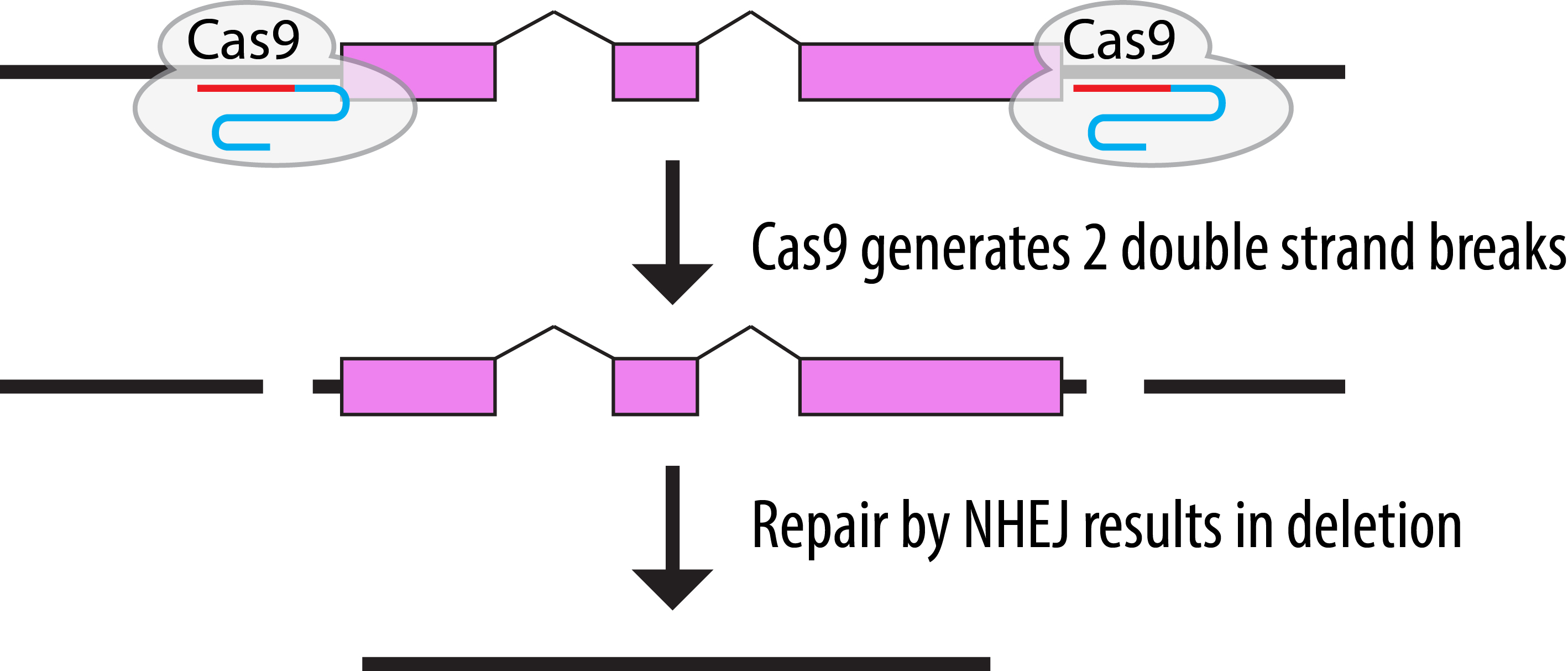To understand gene function it is frequently desirable to obtain a complete molecular null allele of a gene of interest. We previously used the CRISPR/Cas9 system to generate small insertions or deletions as a result of non-homologous end joining (Waaijers et al., 2013). However, alleles generated in this fashion do not necessarily result in complete loss of function. In-frame mutations may not affect protein function, and even early stop codons can be circumvented by alternative splicing or translation initiation at a downstream ATG. For this reason, we developed a method to efficiently generate deletion alleles using CRISPR/Cas9. In experiments targeting a locus with two sgRNAs located closely together, several of the alleles obtained corresponded to a deletion of the intervening sequences (Cho et al., 2013). We tested whether the simultaneous targeting of two sites could be used to generate large deletion alleles through non-homologous end-joining (Figure 1).
We selected three genes of different lengths (1 kb, 5.4 kb, and 11 kb from predicted start to stop). For each gene we designed two sgRNAs, one targeting a sequence before the start codon and the other targeting a sequence after the stop codon, and cloned these into the U6::sgRNA vector pMB70. Next, we injected 30 N2 animals with a mixture containing 5 ng/µl Pmyo-3::mCherry (pCFJ104), 50 ng/µl of each of the two sgRNAs and 50 ng/µl Phsp-16.48::Cas9 (pMB67). To induce expression from the hsp-16.48 promoter, injected animals were heat shocked for 1 h at 34°C on agar plates floating in a water bath, 30 min to 1 hr after injection. From transgenic F1 animals expressing mCherry, we PCR amplified a region surrounding the targeted region to detect the presence of a deletion.
For each of the 3 genes we successfully obtained deletion alleles with the following efficiencies: 3/84 F1 animals for the 1 kb deletion, 13/32 F1 animals for the 5.4 kb deletion, and 1/89 F1 animals for the 11 kb deletion. For 5 of the deletions, we determined the break points by sequencing. For all 5 deletions, the break points were within 11 bp of the predicted Cas9 cut site. One deletion exactly matched the predicted cut sites, and one deletion was accompanied by a small (11 bp) insertion. Thus, by targeting two sites simultaneously the CRISPR/Cas9 system can be used to generate accurately targeted deletions over a wide size range. This approach has two important benefits. First, as it makes use of non-homologous end joining the procedure may be more efficient than homologous recombination-based approaches. Second, the presence of deletions is easily detected by PCR in the F1 generation.
Figures
References
Cho SW, Lee, J, Carroll, D, Kim, J-S, and Lee, J. (2013). Heritable geneknockout in Caenorhabditis elegans by direct injection of Cas9-sgRNA ribonucleoproteins. Genetics 195, 1177-1180. 
Waaijers S, Portegijs V, Kerver J, Lemmens BBLG, Tijsterman M, van den Heuvel S, and Boxem M. (2013). CRISPR/Cas9-targeted mutagenesis in Caenorhabditis elegans. Genetics 195, 1187–1191. 
Articles submitted to the Worm Breeder's Gazette should not be cited in bibliographies. Material contained here should be treated as personal communication and cited as such only with the consent of the author.

Leave a Reply
You must be logged in to post a comment.